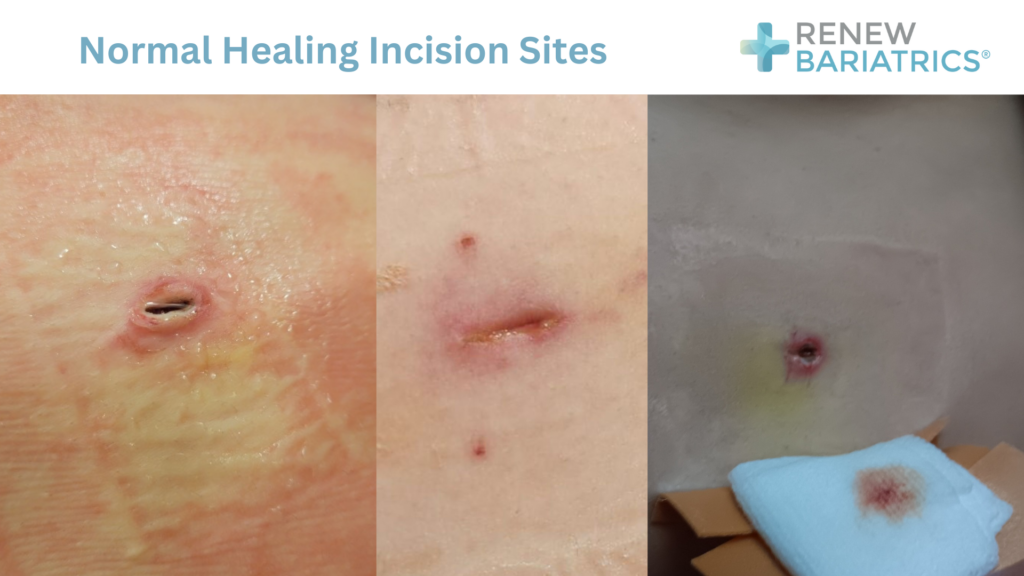Laparoscopic surgery, a minimally invasive technique, has become increasingly common for various medical procedures. While this approach offers benefits such as smaller incisions and quicker recovery times, proper care of the incisions is crucial for a smooth healing process.
In this article, we will provide a comprehensive guide to laparoscopic incision care after bariatric surgery, covering tips for fast recovery, cleaning the incision, what to look for during the healing process, and potential symptoms of infection.
Tips for Fast Recovery after Laparoscopic Bariatric Surgery
Here are some tips to help you recover fast after a laparoscopic bariatric surgery:
- Maintaining Medication Adherence: Your healthcare provider may prescribe pain management and antibiotics to support healing and prevent infections. Strict adherence to the prescribed medication schedule is crucial for a comfortable and effective recovery. Skipping doses or altering the schedule can compromise the healing process and increase the risk of complications.
- Hydration and Nutrition: Proper hydration and nutrition play a pivotal role in recovery. Ensure you stay well-hydrated and follow any dietary recommendations your healthcare team provides. A balanced diet rich in essential nutrients promotes tissue repair and overall well-being, leading to faster recovery.
- No Smoking or Vaping: Smoking or vaping increases the time of recovery and healing. It also reduces oxygen delivery to the tissue that can result in wounds opening or poor healing. Smoking generally causes poor post-operative outcomes.
- Monitor and Report Changes: Pay close attention to any changes in your condition. If you experience unexpected symptoms, changes in pain levels, or unusual side effects from medications, promptly report them to your healthcare provider. Early intervention can address potential issues and contribute to a smoother recovery.
- Respect Rest Periods: While gradually resuming activities is significant, it is equally essential to respect designated rest periods. Adequate rest allows your body to focus its energy on healing. Pushing yourself too soon may impede the recovery process and lead to setbacks. Listen to your body and communicate your activity levels with your healthcare team.
- Mindful Wound Protection: Avoid activities that strain or put undue pressure on the incision site. Avoid tight clothing or anything that might rub against the incision. Conscious wound protection minimizes the risk of irritation or injury to the healing incision, supporting an uneventful recovery.
Cleaning the Laparoscopic Incision
Follow the instructions below to clean the incision properly:
- Prioritize Hand Hygiene: Practice thorough hand hygiene Before engaging in any incision site activities. Wash your hands meticulously with soap and water to minimize the risk of introducing bacteria to the wound. Clean hands are a fundamental aspect of preventing infections during the healing process.
- Gentle Cleaning Techniques: Use a mild soap and warm water when cleaning the incision. Avoid harsh soaps or vigorous scrubbing, as these can irritate the skin. Gently pat the incision dry with a clean, soft towel after cleaning, refraining from rubbing the area to prevent unnecessary friction and discomfort.
- Avoid Unnecessary Moisturizers or Ointments: Unless explicitly recommended by your healthcare provider, avoid applying moisturizers, ointments, or creams to the incision site. These substances can trap moisture, creating an environment conducive to infection. Follow your healthcare team’s guidance on any specific products or practices for incision care.
- Regular Monitoring for Changes: While cleaning, note any changes in the incision site, such as redness, swelling, or unusual discharge. Regular monitoring allows for early detection of potential issues, enabling timely intervention by your healthcare provider
- Avoid Pools and Water: Avoid pools, jacuzzis or sinking in water for at least 2 weeks while wounds heal and seal.
Wound Cleansers
Renew Bariatrics provides the wound cleansers to all bariatric patients. Although, you wont need any specific wound cleaners, some patients want the peace of mind. Here are several we recommend you can get.
|
Primary Rating:
4.7
|
Primary Rating:
4.8
|
|
$9.97
|
$6.68
|
Scarring Gels
Scarring gels can hep reduce scarring when healing. Below are some the scarring gels we recommend.
|
Primary Rating:
4.9
|
Primary Rating:
4.6
|
Primary Rating:
4.6
|
|
$21.01
|
$16.47
|
$19.99
|
What to Look For After Laparoscopic Surgery
After laparoscopic surgery, you should vigilantly monitor your incision for a successful recovery. Understanding both typical healing signs and potential abnormalities ensures timely intervention if needed.
- Typical Healing Signs: As the incision heals, it is expected to experience mild redness, swelling, and discomfort. These symptoms should gradually improve over time.
- Abnormal Signs: Look for signs of infection or complications, such as increasing redness, excessive swelling, persistent pain, pus, or other unusual discharge. If you notice any of these signs, contact your healthcare provider promptly.
- Staples or Sutures: If your incision was closed with staples or sutures, monitor for any signs of their loosening or protrusion. Report any abnormalities to your healthcare provider for further evaluation.
- Changes in Skin Temperature: Pay attention to the skin temperature around the incision site. An increase in localized warmth may indicate inflammation or infection. Conversely, persistent coldness might signal compromised blood flow, requiring prompt evaluation by your healthcare provider.
- Unusual Odor from the Incision: An unexpected foul odor emanating from the incision site could indicate infection. If you notice any unusual smells, it is advisable to contact your healthcare provider promptly for a thorough assessment.

What to Expect After the Laparoscopic Bariatric Surgery
The road to recovery after laparoscopic surgery involves understanding what to expect during the healing process. Here are what to expect:
- Initial Discomfort: It is expected to experience some discomfort or pain in the days following laparoscopic surgery. This can be managed with prescribed pain medications.
- Potential Changes in Bowel Habits: It is not uncommon to experience temporary changes in bowel habits following laparoscopic surgery. Factors such as anesthesia, pain medications, and dietary adjustments can contribute to these changes. Maintaining a balanced diet and staying hydrated can help regulate bowel movements.
- Patients misrepresent constipation on the first week: It’s normal for patients to have no bowel movements before going into solids cause they don’t eat solids to form stool.
- Incisional Healing Phases: Over time, you will witness distinct phases in the healing of your laparoscopic incision. Initially, there might be scabbing and redness, followed by a transition to a pinkish hue as the incision matures. Eventually, the scar will fade, though individual healing timelines may vary.
- Emotional Ups and Downs: The recovery journey is not solely physical; it may also involve emotional ups and downs. It’s normal to experience a range of emotions, including frustration or impatience. Establishing a support system and open communication with your healthcare team can help address the emotional aspects of recovery.
- Return of Normal Activities: Following your healthcare provider’s guidance, you can expect to return to your normal activities gradually. However, avoid strenuous activities once you receive clearance from your surgeon.

Possible Infection Symptoms
Being vigilant for possible infection symptoms is crucial after laparoscopic surgery. Recognizing warning signs enables prompt intervention, ensuring a smoother recovery process.
- Increasing Tenderness to Touch: While some tenderness is expected, a noticeable increase in sensitivity or pain when touching the incision site may indicate an infection. Monitor changes in how your body responds to touch and report any unusual tenderness promptly.
- Persistent Redness and Swelling: If redness and swelling persist or worsen over time, it could indicate an underlying issue.
- Unusual Discharge: Keep an eye on the color and consistency of any discharge from the incision site. Pus, a foul odor, or changes in the discharge may indicate infection.
- Fever: An elevated body temperature, especially if accompanied by other symptoms, such as chills or sweating, could indicate infection.
- Delayed Healing: If the healing process appears slower than anticipated or there are interruptions in the expected phases of wound healing, it could signal an underlying issue. Consult with your healthcare team to evaluate and address concerns about the healing timeline.
- Worsening General Well-being: Pay attention to your overall well-being during recovery. If you notice a decline in energy levels, appetite, or mood, it may indicate an underlying issue. Open communication with your healthcare team allows for a comprehensive recovery evaluation.
Wrapping Up
Proper care of laparoscopic incisions after surgery is crucial for a successful and uneventful recovery.
By following the tips for fast recovery, cleaning the incision with care, monitoring for signs of normal and abnormal healing, and being aware of possible infection symptoms, patients can contribute to their overall well-being during the healing process.
Always consult your healthcare provider if you have concerns or notice any unusual symptoms, as early intervention is critical to addressing potential complications.
Remember, a well-cared-for incision is a step towards a smoother and faster recovery from laparoscopic surgery.







